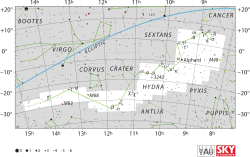Hydra (constellation)
| Constellation | |

|
|
| Abbreviation | Hya |
|---|---|
| Genitive | Hydrae |
| Pronunciation |
|
| Symbolism | the sea serpent |
| Right ascension | 8–15 |
| Declination | −20 |
| Family | Hercules |
| Quadrant | SQ2 |
| Area | 1303 sq. deg. (1st) |
| Main stars | 17 |
|
Bayer/Flamsteed stars |
75 |
| Stars with planets | 18 |
| Stars brighter than 3.00m | 2 |
| Stars within 10.00 pc (32.62 ly) | 4 |
| Brightest star | Alphard (α Hya) (1.98m) |
| Nearest star |
LHS 3003 (20.67 ly, 6.34 pc) |
| Messier objects | 3 |
| Meteor showers |
|
| Bordering constellations |
|
|
Visible at latitudes between +54° and −83°. Best visible at 21:00 (9 p.m.) during the month of April. |
|
Hydra is the largest of the 88 modern constellations, measuring 1303 square degrees. Also one of the longest at over 100 degrees, its southern end abuts Libra and Centaurus and its northern end borders Cancer. It has a long history, having been included among the 48 constellations listed by the 2nd century astronomer Ptolemy. It is commonly represented as a . It should not be confused with the similarly named constellation of Hydrus.
The Greek constellation of Hydra is an adaptation of a Babylonian constellation: the MUL.APIN includes a "serpent" constellation (MUL.DINGIR.MUŠ) that loosely corresponds to Hydra. It is one of two Babylonian "serpent" constellations (the other being the origin of the Greek Serpens), a mythological hybrid of serpent, lion and bird.
The shape of Hydra resembles a twisting snake, and features as such in some Greek myths. One myth associates it with a water snake that a crow served Apollo in a cup when it was sent to fetch water; Apollo saw through the fraud, and angrily cast the crow, cup, and snake, into the sky. It is also associated with the monster Hydra, with its many heads, killed by Hercules, represented in another constellation. According to legend, if one of the hydra's heads was cut off, two more would grow in its place. However, Hercules burned out the roots of the heads he severed to prevent them from growing again, and thus overcame the hydra.
In Hindu Mythology the star that equivalents Hydra is Ashlesha. In Chinese astronomy, the stars that correspond to Hydra are located within the Vermilion Bird and the Azure Dragon. In Japanese culture, the stars are known as Nuriko.
...
Wikipedia
